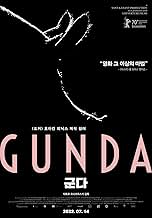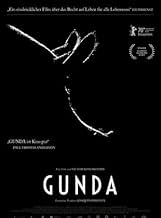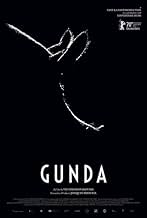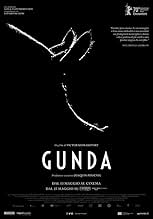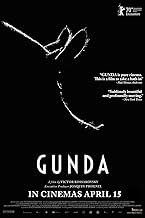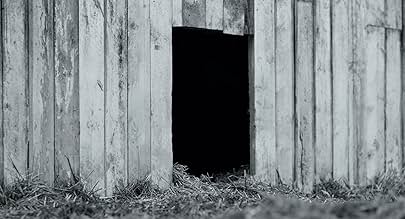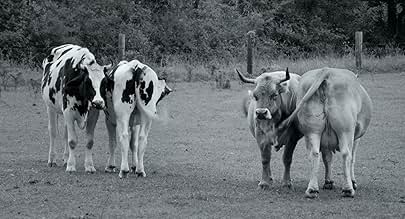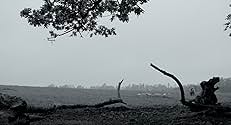CALIFICACIÓN DE IMDb
7.1/10
3.1 k
TU CALIFICACIÓN
Relata la vida cotidiana de un cerdo y sus compañeros de granja: dos vacas y una gallina con una sola pata.Relata la vida cotidiana de un cerdo y sus compañeros de granja: dos vacas y una gallina con una sola pata.Relata la vida cotidiana de un cerdo y sus compañeros de granja: dos vacas y una gallina con una sola pata.
- Dirección
- Guionistas
- Elenco
- Premios
- 9 premios ganados y 32 nominaciones en total
- Dirección
- Guionistas
- Todo el elenco y el equipo
- Producción, taquilla y más en IMDbPro
Opiniones destacadas
IN BRIEF: A well-made but slow moving pig's tale.
JIM'S REVIEW: (RECOMMENDED) A pig and her litter, a one-legged chicken, and some cows are the main cast in this fine documentary, Gunda, Viktor Kosakovskiy's understated cinematic plea for animal rights.
Gunda is an enormous sow that has just given birth to a dozen small piglets. This is their story of life down on the farm. Call me a city boy, but the film depicts the daily mundane weeks in this pig's heaven (or hell) and I have chosen the right lifestyle for me. Still, it is a fascinating place to visit.
There are no voiceovers, no sweeping musical score, no Disney sentimentalizing... just straight-forward filming of natural country events. There are many grunts, squeals, and moos to be heard and lots of mud and flies buzzing around too.
This is a well-made documentary that tries to convey an animal's everyday existence. The wonderful sound design by Alexander Dudarev immerses the moviegoer into this rarely-seen animal kingdom. The masterful b&w photography by Egil Håskjold Larsen and the director is stunning with its low-level point of view and detailed close-ups of farm critters.
However, the story seems non-existent and Mr. Kosakovskiy lets scenes go on for far too long, at a turtle's pace, although none of those creatures are in sight. The documentary does eventually build to its subtle message about the cruelty of our food chain, but any astute moviegoer knows the fate of our little dirty dozen from the start. (A side note: All of our violent deeds are strongly implied, but mercifully not shown.) I could say there is much food for thought in this documentary, but then I would be called insensitive or callous. Let's just say, this film deserves your attention. (GRADE: B-)
JIM'S REVIEW: (RECOMMENDED) A pig and her litter, a one-legged chicken, and some cows are the main cast in this fine documentary, Gunda, Viktor Kosakovskiy's understated cinematic plea for animal rights.
Gunda is an enormous sow that has just given birth to a dozen small piglets. This is their story of life down on the farm. Call me a city boy, but the film depicts the daily mundane weeks in this pig's heaven (or hell) and I have chosen the right lifestyle for me. Still, it is a fascinating place to visit.
There are no voiceovers, no sweeping musical score, no Disney sentimentalizing... just straight-forward filming of natural country events. There are many grunts, squeals, and moos to be heard and lots of mud and flies buzzing around too.
This is a well-made documentary that tries to convey an animal's everyday existence. The wonderful sound design by Alexander Dudarev immerses the moviegoer into this rarely-seen animal kingdom. The masterful b&w photography by Egil Håskjold Larsen and the director is stunning with its low-level point of view and detailed close-ups of farm critters.
However, the story seems non-existent and Mr. Kosakovskiy lets scenes go on for far too long, at a turtle's pace, although none of those creatures are in sight. The documentary does eventually build to its subtle message about the cruelty of our food chain, but any astute moviegoer knows the fate of our little dirty dozen from the start. (A side note: All of our violent deeds are strongly implied, but mercifully not shown.) I could say there is much food for thought in this documentary, but then I would be called insensitive or callous. Let's just say, this film deserves your attention. (GRADE: B-)
A small film, a moving and beautiful film, a film that moves at the pace of farm animals.
It is set in another universe that is open to us but that we don't visit.
It is set in another universe that is open to us but that we don't visit.
Greetings again from the darkness. We open on a pig in prone position with her head sticking through an opening in the barn. It takes a minute to realize the sow isn't sleeping, but rather giving birth. Slowly the newborn piglets begin tumbling out into the world. Cutting to a reverse camera angle, we see the 12-13 babies desperately trying to latch onto mom for their first meal. The runt of the litter struggles more than the others. Award-winning filmmaker Viktor Kosakovskiy runs this first segment just over 19 minutes. There is no dialogue. No human on screen. The soundtrack is all natural from nature: the snorts from mama sow, the squeals from piglets, and unseen birds chirping.
Our second segment finds roosters in a crate. Clearly new to the surroundings, and likely never-before "free" to roam the land, these chickens cautiously explore as the camera focuses on their tentative initial steps from the cage and startled reactions to birds. A one-legged rooster captures our attention as it makes its way through the grass and over fallen logs. It's likely the longest amount of time a movie camera has been dedicated to following roosters around.
We then head back to find the piglets have grown substantially. We don't know how much time has passed, but we watch along with their mother as the youngsters play in the field, fight with each other, and bully their youngest sibling. Gunda, the mother sow, watches over them just as any mother would watch over her kids. Our third group is introduced as the barn door opens and the cows are released. They romp into the fields like school kids at recess. Some of the cows stare directly into the camera as if to inform us they are ready for their close-up. It's fascinating to see how they use teamwork for an ingenious head-to-tail solution to the annoying flies that relentlessly pester them.
The final segment returns us to the pigs as they display the same feeding frenzy as one might witness at the buffet on a Carnival cruise. An ending that will surely evoke emotions in viewers, though maybe not at the extreme of Gunda herself. Filmmaker Kosakovskiy leaves us wondering how a black and white film with no dialogue or human characters makes such an impression as it focuses on farm animals. Pork, chicken, and beef. Clearly it's no coincidence that he chose three staples of the American diet. There is no lecture on animal rights, and none of the brutality of other "raised for food" documentaries is shown. But the message is there. It was filmed on farms in Norway, Spain, and the U. K., but the locales matter little. Director Kosakovskiy previously brought us the excellent AQUARELA (2018), a documentary showcasing the nature of water and ice, and here he assisted Egil Haskjold Larsen with cinematography, and Ainara Vera with editing. It's an unusual film, and one meant to inspire reflection and thought ... and hopefully change.
In theaters beginning April 16, 2021.
Our second segment finds roosters in a crate. Clearly new to the surroundings, and likely never-before "free" to roam the land, these chickens cautiously explore as the camera focuses on their tentative initial steps from the cage and startled reactions to birds. A one-legged rooster captures our attention as it makes its way through the grass and over fallen logs. It's likely the longest amount of time a movie camera has been dedicated to following roosters around.
We then head back to find the piglets have grown substantially. We don't know how much time has passed, but we watch along with their mother as the youngsters play in the field, fight with each other, and bully their youngest sibling. Gunda, the mother sow, watches over them just as any mother would watch over her kids. Our third group is introduced as the barn door opens and the cows are released. They romp into the fields like school kids at recess. Some of the cows stare directly into the camera as if to inform us they are ready for their close-up. It's fascinating to see how they use teamwork for an ingenious head-to-tail solution to the annoying flies that relentlessly pester them.
The final segment returns us to the pigs as they display the same feeding frenzy as one might witness at the buffet on a Carnival cruise. An ending that will surely evoke emotions in viewers, though maybe not at the extreme of Gunda herself. Filmmaker Kosakovskiy leaves us wondering how a black and white film with no dialogue or human characters makes such an impression as it focuses on farm animals. Pork, chicken, and beef. Clearly it's no coincidence that he chose three staples of the American diet. There is no lecture on animal rights, and none of the brutality of other "raised for food" documentaries is shown. But the message is there. It was filmed on farms in Norway, Spain, and the U. K., but the locales matter little. Director Kosakovskiy previously brought us the excellent AQUARELA (2018), a documentary showcasing the nature of water and ice, and here he assisted Egil Haskjold Larsen with cinematography, and Ainara Vera with editing. It's an unusual film, and one meant to inspire reflection and thought ... and hopefully change.
In theaters beginning April 16, 2021.
...although more of the story of the chickens and cows life would have balanced it better.
Many informative reviews here already, hence I wanted to add some facts I looked up afterwards, also as some here got it wrong, but I won't as I don't like spoilers. You find every question which (hopefully) pops up afterwards by doing a quick search.
I'll only leave a good note I liked from AccidentalSmallHolder net ehich addresses something you'll (hopefully) also think about afterwards:
"If pig keeping isn't for you, please do the next best thing and source your pork, bacon and sausages from ethically reared pigs. If it doesn't say the pigs are born and reared outdoors, they probably weren't so don't be fooled by misleading labelling. Even pigs that are reared outdoors may have been born to sows kept indoors, in crates, so do be aware of labelling - it's more about what it doesn't say, than what it does."
Many informative reviews here already, hence I wanted to add some facts I looked up afterwards, also as some here got it wrong, but I won't as I don't like spoilers. You find every question which (hopefully) pops up afterwards by doing a quick search.
I'll only leave a good note I liked from AccidentalSmallHolder net ehich addresses something you'll (hopefully) also think about afterwards:
"If pig keeping isn't for you, please do the next best thing and source your pork, bacon and sausages from ethically reared pigs. If it doesn't say the pigs are born and reared outdoors, they probably weren't so don't be fooled by misleading labelling. Even pigs that are reared outdoors may have been born to sows kept indoors, in crates, so do be aware of labelling - it's more about what it doesn't say, than what it does."
Looks like this film sometimes can't decide what it wants itself to be. Overall, it uses a highly poetic language with desaturated picture and "commercial" outlook with long dolly shots, wide angles and slow motion. At the same time, it always tends to be on animals' eyes level, depicting some of the unpleasant and cruel aspects of their life. However, it seems that camera is sometimes shy about what it sees, notably putting pig's back out of focus in final scene - which inevitably drives us to a conclusion that it's the human look on the animal, even if there's not a single human in frame. Surprisingly, the most coherent and touching part of three isolated novels is the one about chicken - particularly because of non-intrusive and highly tactile camera work.
Gunda stays somewhere between brutal realism of life and romantic pamphlet against cruelty to animals, mixing together two incompatible aesthetic approaches. However, a film like this had to be made, and I hope it will influence other filmmakers to experiment with storytelling from an animal point of view.
Gunda stays somewhere between brutal realism of life and romantic pamphlet against cruelty to animals, mixing together two incompatible aesthetic approaches. However, a film like this had to be made, and I hope it will influence other filmmakers to experiment with storytelling from an animal point of view.
¿Sabías que…?
- TriviaJoaquin Phoenix and Paul Thomas Anderson were amongst the first people in the industry to publicly praise the film.
- ErroresGunda is shown wallowing in mud and the mud covers her teats. In the next sequence, her piglets suckle her teats which are suddenly clean.
Selecciones populares
Inicia sesión para calificar y agrega a la lista de videos para obtener recomendaciones personalizadas
Detalles
- Fecha de lanzamiento
- Países de origen
- Sitios oficiales
- Idioma
- También se conoce como
- Gunda: Mother, Pig
- Locaciones de filmación
- Grøstad farm, Undrumsdal in Tønsberg municipality, Noruega(the pig farm location)
- Productoras
- Ver más créditos de la compañía en IMDbPro
Taquilla
- Total en EE. UU. y Canadá
- USD 115,691
- Fin de semana de estreno en EE. UU. y Canadá
- USD 5,023
- 18 abr 2021
- Total a nivel mundial
- USD 383,128
- Tiempo de ejecución
- 1h 33min(93 min)
- Color
- Relación de aspecto
- 1.85 : 1
Contribuir a esta página
Sugiere una edición o agrega el contenido que falta



